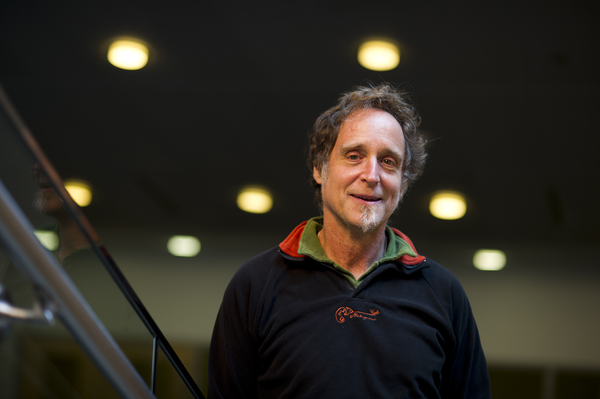For music professor, digital art is a new frontier

Dennis Miller is a professor of music in the College of Arts, Media and Design, but his latest artistic achievement uses animation instead of sound, opening a new wave of possibilities for communicating concepts and themes.
Several of Miller’s pieces are on display on the 80-foot-tall multiscreen LED outside the Boston Convention & Exhibition Center as part of a public media art exhibit titled “Art on the Marquee.” Presented by Boston Cyberarts and the Massachusetts Convention Center Authority, the exhibit features video art by six Massachusetts artists, whose work is viewed by some 10,000 visitors each day.

Dennis Miller’s art is on display on the 80-foot screen outside the Boston Convention and Exhibition Center. Photo by Dennis Miller.
[media-credit id=19 align=”alignright” width=”200″][/media-credit]Miller’s work features bold colors and geometric shapes, which evolve and distort over time without following a narrative structure.
His career at Northeastern began 32 years ago with a focus on composing traditional acoustic music. Only later did he shift toward electronic music and animation.
“It’s been a different way to approach the work,” Miller said of his foray into animation. “Whichever way the narrative develops has to be purely visual. It’s a challenge, but it’s a fun challenge.
“The biggest revelation to me when I moved into imagery was the massive scope of what became possible,” he added. “It was not out of the question that something like a film festival would be interested in my work. It created a lot more opportunities than just music provided.”
Part of the artistic transition was guided by pure logistics: Adopting a new medium allowed Miller to display his work in a variety of new settings, from film festivals to public spaces. But it has also allowed him to push beyond the traditional confines of music and explore the furthest edges of his field.
Miller’s process of using animation to visually convey themes and concepts is similar to his process of composing music, which is incorporated into the majority of his work.
“What I’m doing is developing and organizing the images the same way you might in a musical composition,” Miller said. “Because I’m using abstract imagery, I will often let the music guide the imagery. There’s no text, there’s no story — there’s just imagery.”
Boston, he said, has become a hotspot for digital music and art, with Northeastern leading the charge. Snell Library, for example, has a burgeoning digital music and art archive, and students from across disciplines are embracing animation and new media classes.
“It’s not something you’ll find in too many other areas of Boston, so we’re becoming known for it,” Miller said.
Later this year, Miller’s artwork will be on display at a Wheaton College exhibition and at festivals in Germany and elsewhere in Europe and Asia.
The artwork continues to change as Miller continues to perfect his craft. “Large public spaces are an exciting venue for an artist, and though I’ll continue to look for new opportunities, I’m always open to whatever challenges the next phone call will bring,” he said.




